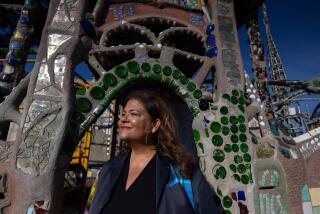B. Lowry, 80; Architecture, Art Historian
- Share via
Bates Lowry, a leading art and architectural historian who was founding director of the National Building Museum in Washington, D.C., and oversaw its birth in the 1980s, has died. He was 80.
Lowry died March 12 at a hospital in Brooklyn, N.Y., of complications from pneumonia.
He spent years in academia, holding teaching positions at colleges from Massachusetts to California. He also wrote books on subjects ranging from Renaissance art to the daguerreotype. On many projects he worked with his wife, art researcher and mathematician Isabel Barrett Lowry.
Lowry’s professional profile grew in the mid-1960s after he raised money to salvage and restore art damaged by extensive flooding in Florence, Italy. Recruited in 1968 as director of the Museum of Modern Art in New York, he spent less than a year in the job because of differences with key museum officials about expansion plans; many of his ideas were later implemented.
In 1980, Congress chartered the National Building Museum, and Lowry went to Washington to turn what had been the old Pension Building into a museum and research center about American architecture, construction and urban planning.
The building was a decaying structure from the 1880s, and Lowry spent his first five years lobbying politicians to fund the rehabilitation. Some members of Congress, the executive branch and the General Services Administration, which financed the renovation and maintenance of the museum, spent years debating the need for the project and the time and money necessary to complete it.
Lowry helped overcome much of this early skepticism with his vision for the museum, which now has about 320,000 visitors annually.
When the museum opened in 1985, Lowry told the Washington Post: “Americans have been more apt to study the great palaces of Europe than our own architecture. This museum will try to see to it that, at an early stage in their education, Americans know what our important buildings are, and what a record those buildings are of their own society.”
Robert Peck, who in the early 1980s worked for Sen. Daniel Patrick Moynihan (D-N.Y.), a museum champion, said Lowry “was determined at a time when the museum had almost no resources. His vision was to have the highest museum and academic standards.”
Lowry left the museum in 1987 and returned to his research and writing.
A Cincinnati native, he attended the University of Cincinnati until his college career was interrupted by Army service at the end of World War II. While he was in France and Germany, his interest in art history took hold.
He later earned a master’s degree and a doctorate, both in art history, from the University of Chicago, where he also taught. He also held teaching positions at UC Riverside, Pomona College and New York University.
While chairman of the art department at Brown University in the 1960s, Lowry was president of the Committee for the Rescue of Italian Art, for which he raised money after the floods in Florence.
Impressed with his organizational skills, Rene D’Harnoncourt, the director of the Museum of Modern Art, hired the largely unknown Lowry to succeed him. Within weeks, D’Harnoncourt died after being hit by a car.
Lowry did not have the benefit of a longer transition. A daunting fundraising project and a drive to persuade departmental heads to work in closer conjunction with one another led to some strains, said William Lieberman, a former museum colleague who is now chairman of the modern art department at the Metropolitan Museum of Art in New York City.
Lowry had the support of some trustees but not the museum’s president, CBS founder William Paley. Within a year, Lowry resigned, citing “personal considerations.”
He became chairman of the art department at the University of Massachusetts at Boston.
Lowry’s books include “Visual Experience: An Introduction to Art” (1961), “Renaissance Architecture” (1962) and “Silver Canvas: Daguerreotype Masterpieces from the J. Paul Getty Museum” (1998), the last co-written with his wife.
Isabel Lowry died in December. Survivors include two daughters, four grandchildren and a great-granddaughter.
More to Read
The biggest entertainment stories
Get our big stories about Hollywood, film, television, music, arts, culture and more right in your inbox as soon as they publish.
You may occasionally receive promotional content from the Los Angeles Times.










